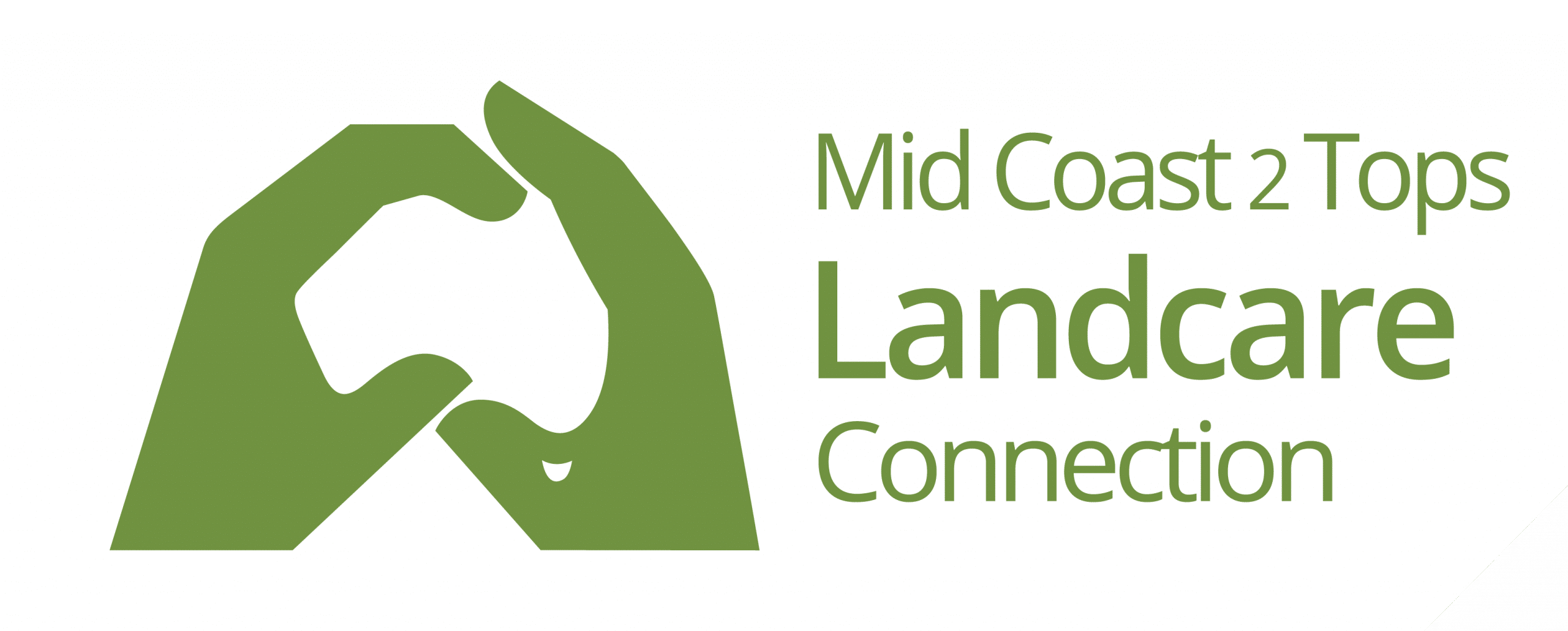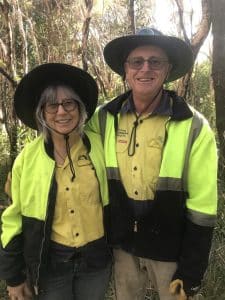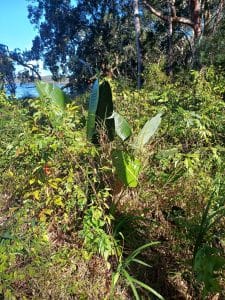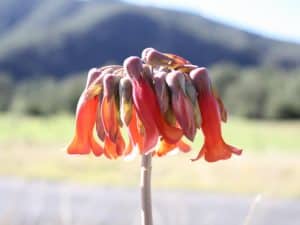Regular attendees of local Landcare field days may have run into a lovely friendly old gentleman getting around with the aid of a rolling walker. Les Roberts is happy participating as a “punter” these days, and few in the current Landcare community know how influential he has been in the Landcare movement in the region and more broadly. Les was a founding member of Dyers Crossing Landcare in 1999, the founding President of Karuah & Great Lakes Landcare network in 2003, and he sat on the inaugural Committee meeting of Landcare NSW in 2007. He worked closely with the former Great Lakes Council, including as a committee member of the Wallis Lake Catchment Implementation Group and Coastal Catchment Initiative committee. Les put a big commitment into supporting the planning and implementation of Great Lakes Council’s award-winning Sustainable Farming Program, which enabled the formation of new Sustainable Farming groups around the Great Lakes area in 2007-2010.
As a farmer Les led by example, an early adopter of Organic farming and a Regenerative Agriculture practitioner before the term was talked about, building healthy soil and biodiversity while running a successful farm business. His farm at Dyers Crossing, “Clondella” was host to many field days, showcasing riparian protection and vegetation regeneration, off-stream watering, managed intensive grazing, shiny happy cattle and a diverse pasture that stayed green through the winter and well into dry times. His down-to-earth approach, sense of humour and well-rounded practical expertise made him a natural leader who could reach and positively influence a diverse landholder audience. Hundreds of landholders over the years have benefited from training organized, facilitated or directly delivered by Les – Farm OH&S, Prograze, Chemcerts, Biological farming, Artificial Insemination, Electric fencing, Pipe laying, Yeomans Plow use, environmental management systems, backhoe and loader certification, Cattlecare, MYOB, etc, etc.
Great Lakes Local Landcare Coordinator Joël Dunn recently caught up with Les for some reflection on life in Landcare. Here is a lightly edited transcript of their conversation.
Joël: Thanks for having me
Les: Thanks for coming in, Joël. I don’t get the chance to see you very much anymore, been out of Landcare for a long while
Joël: You still keep a toe in…
Les: I still keep in with them, still a lifetime member, Alice and myself, Alice passed away 12 months ago, from motor neuron disease. It knocked her around.
I still go out to a lot of field days, actually today I was out at Laura’s place at Firefly for a meeting. They’re talking about doing away with Dyers Crossing Landcare, and making it Wallamba Landcare, joining together with the Wang Wauk Sustainable Farming Group. It’s going to be a big membership, and they’re still very interested, that’s the main thing, keeping it going. Robyn Lamond has left the MidCoast 2 Tops Committee and will be helping Laura out there.
Joël: You’ve been in it a long time, when did you start in Landcare?
Les: In 1999 we started the Dyers Crossing Landcare Group, but I was always doing that work, before I went into Landcare.
Joël: Were you always farming?
Les: Since I was born! I was born at Parramatta, and lived at Maroota til I was about 19 and that was when we bought the farm out at Wang Wauk Rd at Dyers Crossing. We had 235 hectares originally, and we sold a few acres to raise money for fencing. And we lived there for about 55 years.
Joël: I gather you were a bit unconventional for your time?
Les: Very unconventional. When we started we only had Jersey cattle on the farm, and I wasn’t real happy with them, they weren’t milking very well, so I started changing them over to Friesian-Jersey cross, and I got into that for a while, but when we went to Australian Milking Zebu cattle, that was what we stayed with from then on, about 40 years on. When I got over to the AMZs through artificial insemination, I didn’t have to treat them at all, not even for worms. They just acclimatized to the farm. There were a few farms around Dyers Crossing I AI’d with AMZ genetics, but they weren’t dairies. They go well as beef cattle as well. When we went over to beef around 2005, I used to put an Angus bull over them or a Brahman bull, and rear the calves up. When we sold the place, we got good money for those Australian Milking Zebus.
I ran into a fellow from Lismore who was importing Dung Beetles from South Africa, and he asked me if I would be interested and I said “Yeah I’ll be interested in that but there’s a catch to it – it’s got to be enough for 25 farms, because I’m not just doing it on one farm”. He said “that’s fine, we’ll rear them up.” So they reared them up in Lismore and they brought them down in boxes, and we distributed them all around the Dyers Crossing area, and they’re still there to this day. Laura out there at Firefly still has them at her place even though they’ve had cattle off for a little while.
But, doing Landcare became a full time job, it could be 35 hours a week volunteering. I went to Lismore, went to Canberra when I was representing Karuah & Great Lakes Landcare (KGL).
Joël: When did KGL get going? How was that idea conceived?
Les: KGL was set up in 2003, the funding was better suited to regional networks than the local catchment groups. We kept the Dyers Crossing group as it was, and we formed a regional Committee along with the Karuah Catchment Landcare folk, and we got an office, where you are now at the Nabiac Neighbourhood Centre next to the Preschool, we had a single room, we used to meet there. I used to go in there one day a week to start off with, I’d stop there for 3 or 4 hours. We left a lot of information there, we had the phone on there, and we had a lot of people call in there at different times. We helped new local groups get going, and they are still at it to this day.
I eventually handed it over to Robyn Lamond, quite a few years ago.
We had plenty of field days at home. We did Waterwatch and we showed them how to collect water from the dam, put it through a sieve and sit down at a table and find the different insects and that and list down which ones we could find, and compare it with what should be there with high water quality. One day one of them caught a snake in his dipnet, he didn’t know what to do! So he dropped the net and ran for his life. I had to go and rescue it, a little red belly black snake.
So there was all sorts of work around here…artificial insemination, I taught that, and Prograze, OH&S, how to drive tractors, how to drive grader blades, how to drive rollers.
What else?… Soil conservation. How to use a mulcher, instead of using a slasher. Taught them how to use a single tyne ripper with a drop thing on the back to drop in two inch poly pipe, put it out for stock water and irrigation. I did 50 acres of irrigation set-up on our own farm. I taught other people how to use it, used to loan it out, until one day it disappeared. Then more recently I bought another one for the group to use, and it’s been getting around.
We used to do a lot of sod seeding with different varieties of seeds, rye and clover, wheat, oats, barley, all that sort of thing. We had a direct drill, didn’t work the pasture up, just planted straight into the grass with a chain harrow on behind the sod seeder. Taree produce used to supply chicken litter, they had a chap there doing it, a bloke used to come with a five tonne truck and spread it.
Joël: I remember your place always looking green…
Les: the grazing management was the big thing, that was an ongoing thing.
Joël: What advice would you give to someone who’s starting out on a farm?
Les: To study their soil, and work out what’s in their soil. Talk to the previous owners and find out what they did with it. A lot of properties around here, after we started doing Landcare, they changed over to using Organic products like chicken litter and manures and guano and that type of thing. A lot of them did still have to use dolomite or lime to get their acidity back to a reasonable level, because there is a lot of acidity on the coast, and I still think a lot of farms need to be testing their soil pH.
Every two years we would leave a paddock to seed itself, and with natural reseeding you’re way ahead compared to buying seed in, they adapt to local conditions and they can seed themselves year-in year-out.
Another simple but important thing is – don’t use a slasher. Use a mulcher. Because if you use a slasher you’re just creating windrows along each row you slash, but with a mulcher you’re putting the whole lot on the ground, and it’s like a fertilizer on your grass. It might be a bit dearer to buy a mulcher but in the long run you’re way ahead. You go over it slowly, but you’re mulching it up and it does a much better job. You’ll find your grass will come away a lot quicker.
I used to mulch straight after grazing, and because my cattle were always moving, that mulcher got used seven days a week.
Joël: What was the grazing regime?
Les: I would move them twice a day, shifting an electric fence morning and night. Depending on the number of cattle, when we were milking 90 head we’d do about a third of an acre a feed. They’d have that third of an acre for the day, then I’d put my dog around, I had a dog I didn’t even have to tell what to do, I always had a dog with me, always. He’d put the cows out and he’d sit at the gate, I didn’t even have to go and shut the gate, all I had to do was run the electric fence behind them, down and across, back-fence them, make a laneway down so they could get to the trough, I’d do two electric fences twice a day, and that was the secret.
Joël: Thank you kindly Les
Joël Dunn met with Les Roberts for this interview in January 2025




